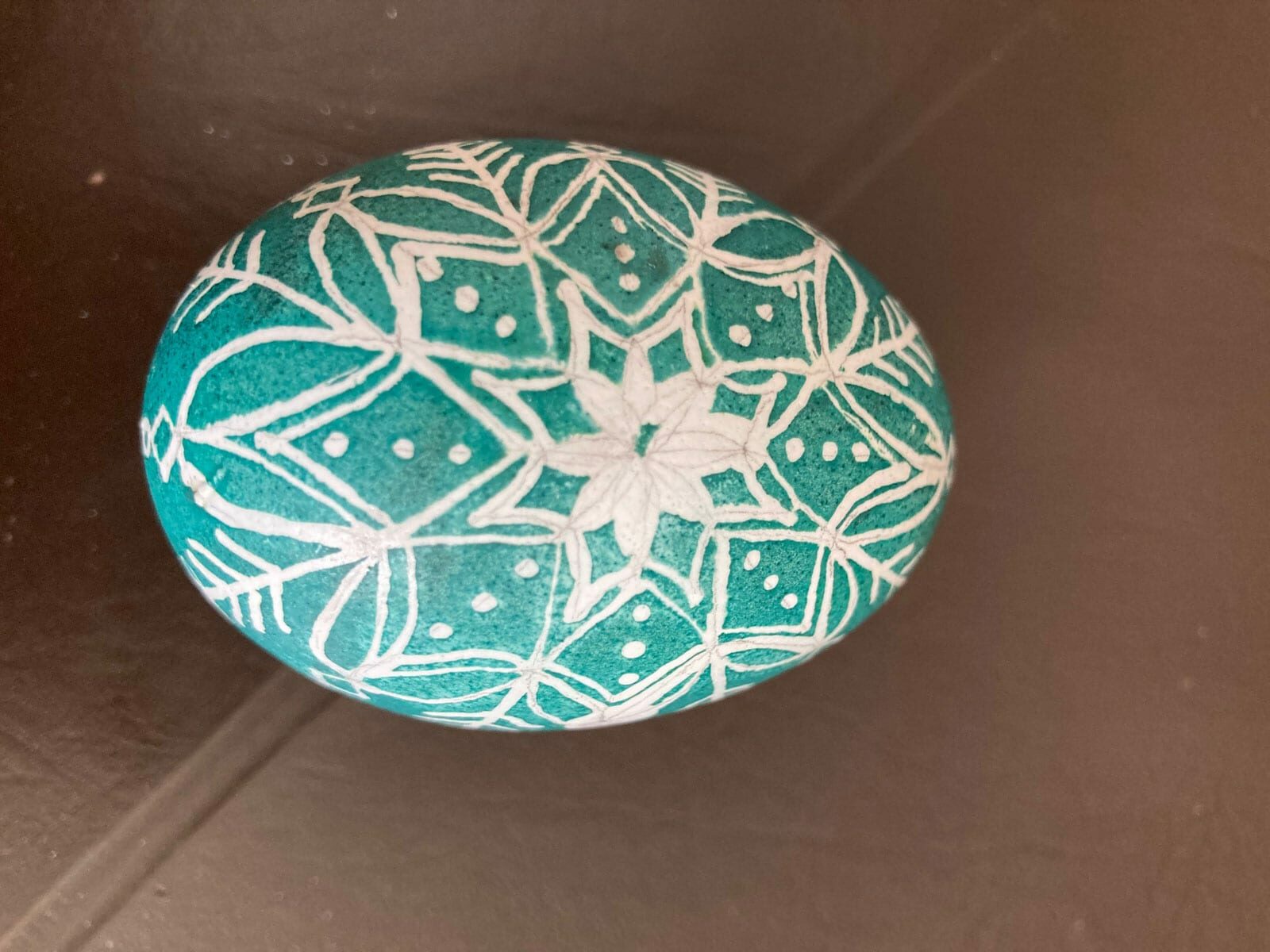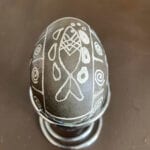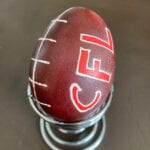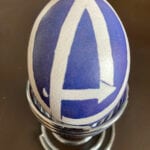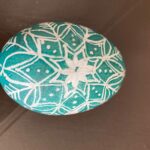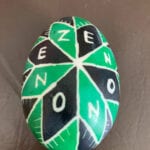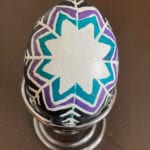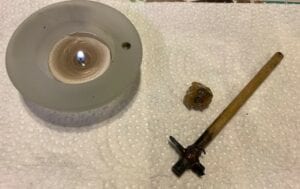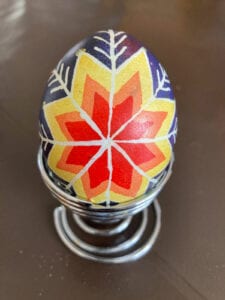 Ukrainian Easter eggs are an art form all to themselves. They are an essential part of some Ukrainian religious services but are also made for fun, given as gifts, and even sold online. The Grizzly Gazette spoke to Tara LaBerge from Swan Hills, Alberta, to learn more about these works of art.
Ukrainian Easter eggs are an art form all to themselves. They are an essential part of some Ukrainian religious services but are also made for fun, given as gifts, and even sold online. The Grizzly Gazette spoke to Tara LaBerge from Swan Hills, Alberta, to learn more about these works of art.
Tara grew up in the Ukrainian community in Winnipeg, Manitoba, active in the Ukrainian Catholic Church and attending one of the city’s Ukrainian schools until she reached junior high.
The proper name for Ukrainian Easter eggs is pysanka when referring to a single egg, or pysanky for more than one egg. There are many traditional designs and symbols used in decorating pysanky, each with its own meaning. Much of the symbology is religious in nature.
Pysanky are an important part of the traditional Easter celebration in the Ukrainian Catholic Church. Families will pack an Easter basket with everything that they will have for their Easter meal, with decorative pysanky, to be blessed with holy water at their church on Holy Saturday (the day before Easter Sunday). The Easter meal will be eaten on Easter Sunday. Pysanky are made with non-edible dyes, and the contents of the egg are sometimes removed during the process, which means that they are not a part of the meal. Krashanky are hard-boiled eggs that have been coloured with edible dyes and can be eaten.
- Ukrainian Easter eggs are an art form all to themselves
Certain items and tools are necessary to make pysanky. The more common items are a pencil to mark the designs on the egg, a candle to provide heat for the process, and jars to contain the dyes. Then there are the more specialized items, such as the traditional dyes used to colour the egg, the kistka (traditionally a small copper funnel with a wooden handle) to apply beeswax to the egg, and beeswax. These items are available at Ukrainian stores and gift shops and can also be ordered online. Many different types of eggs can be used, including eggs from chickens, ducks, geese, and even emus and ostriches.
Tara started to learn how to make pysanky at home when she was four years old. Young children start out by learning the basics of this process, such as drawing lines and squiggles with a kistka and using the traditional dyes to achieve their desired colours at the end of the process. The children are taught the traditional symbology used in decorating the pysanky along the way. And importantly, they learn how to keep from starting fires with the open flame of the candles. Tara also worked on pysanky at church as a member of the Children of Mary.
Tara continued to learn about making pysanky every year at school. Students in earlier grades have a fair bit of freedom in how they decorate their pysanky, focusing on refining the basic skills. The lessons became much more structured in grade four, focusing on learning how to make authentic traditional designs. Students at this stage begin by planning their designs on paper and then continue in a step-by-step process as a class until they achieve their desired result.
Tara enjoys being creative with her pysanky, having fun with stepping outside traditional designs at times. She has made pysanky with Halloween themes, movie themes, and other creative designs. Tara has also gifted friends with monogrammed eggs. She enjoys making pysanky, finding it to be a relaxing pastime.
Creating pysanky is an involved process that requires a lot of initial planning to achieve specific results. Much of the planning has to do with the dyes. The eggs are dyed in stages, starting with the lightest colours and then in successively darker colours. The different coloured dyes will act on the dyes from previous steps to create new colours, so achieving a person’s desired end result involves picturing how they want their finished egg to look and then thinking backward through the stages of dyeing to figure out where to begin and which colours to use.
The traditional dyes can make quite a mess, so it is a good idea to lay out newspaper over the intended work surface and make sure that there is a decent supply of paper towels at hand. Paper plates can help provide a place to set the egg down and catch any wayward melted beeswax.
Once a person has a “game plan,” they can lightly draw their design on the egg with a pencil. Any lines or parts of the egg that are intended to stay white (or the egg’s natural colour) must be coated with beeswax to prevent the dyes from colouring that area. It is important to note that any place that beeswax has been applied to will not absorb the dyes properly, even if the beeswax is subsequently removed.
Beeswax is applied with the kistka. The funnel of the kistka has a wide end and a narrow end. The wide end is for scooping the beeswax, and the narrow end is for applying the wax to the egg. To fill the kistka with beeswax, heat the funnel’s wide end over the candle’s flame and then glide this part of the kistka through the wax. After the kistka has been “loaded” with beeswax, heat the narrow end over the candle flame to melt the beeswax. When the melted beeswax first begins to flow through the kistka, it tends to come out in heavier blobs, so it is a good idea to draw a couple of lines on some of the newspaper until the wax flows in a smoother and more controlled fashion. Once the wax is flowing evenly, it is time to cover any lines or areas that are intended to remain white.
After the beeswax has been applied, lower the egg is into the lightest colour of dye to be used. Leave the egg in the dye for up to 15 minutes. The egg will need to stay in the dye for longer periods to achieve deeper and richer colours. Gently remove the egg when it has reached the desired colour, handling it and drying it off with a paper towel.
If any parts of the egg are intended to stay this colour, they will need to be coated with beeswax. Then the egg moves on to the next dye. Continue with this process until the egg has been dyed with all of the intended colours, then dry it off thoroughly with a paper towel.
Now it is time to remove the beeswax. This part of the process has a bit of a learning curve because the egg has to be held over the candle’s flame to melt the beeswax, but it can’t be held too close to the flame, or the egg will get scorched and blacken. Once the beeswax has melted in the heated area, wipe it off with a paper towel. Continue this process until all of the beeswax has been removed.
Congratulations, you now have a pysanka!

